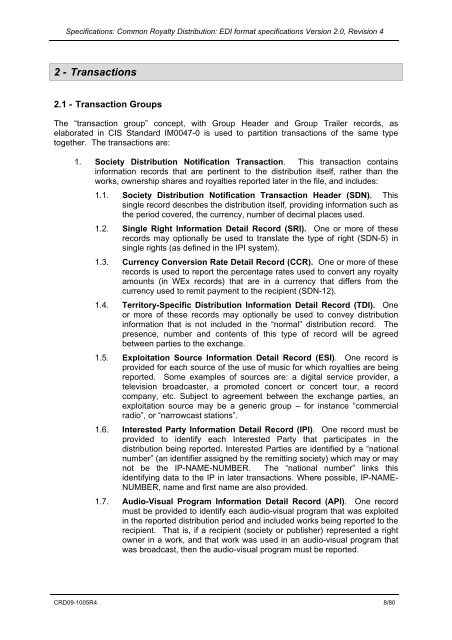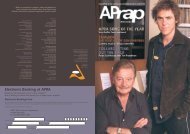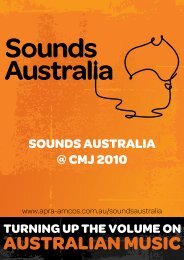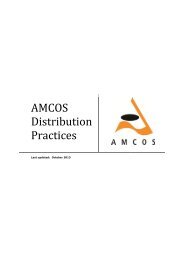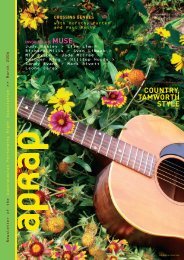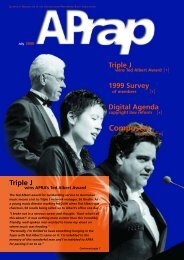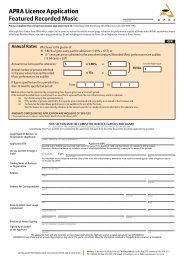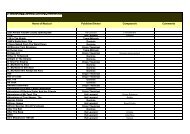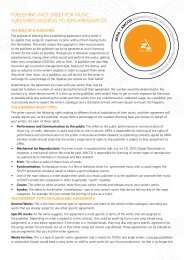EDI format specifications Version 2.0, Revision 4 - APRA
EDI format specifications Version 2.0, Revision 4 - APRA
EDI format specifications Version 2.0, Revision 4 - APRA
You also want an ePaper? Increase the reach of your titles
YUMPU automatically turns print PDFs into web optimized ePapers that Google loves.
Specifications: Common Royalty Distribution: <strong>EDI</strong> <strong>format</strong> <strong>specifications</strong> <strong>Version</strong> <strong>2.0</strong>, <strong>Revision</strong> 4<br />
2 - Transactions<br />
2.1 - Transaction Groups<br />
The “transaction group” concept, with Group Header and Group Trailer records, as<br />
elaborated in CIS Standard IM0047-0 is used to partition transactions of the same type<br />
together. The transactions are:<br />
1. Society Distribution Notification Transaction. This transaction contains<br />
in<strong>format</strong>ion records that are pertinent to the distribution itself, rather than the<br />
works, ownership shares and royalties reported later in the file, and includes:<br />
1.1. Society Distribution Notification Transaction Header (SDN). This<br />
single record describes the distribution itself, providing in<strong>format</strong>ion such as<br />
the period covered, the currency, number of decimal places used.<br />
1.2. Single Right In<strong>format</strong>ion Detail Record (SRI). One or more of these<br />
records may optionally be used to translate the type of right (SDN-5) in<br />
single rights (as defined in the IPI system).<br />
1.3. Currency Conversion Rate Detail Record (CCR). One or more of these<br />
records is used to report the percentage rates used to convert any royalty<br />
amounts (in WEx records) that are in a currency that differs from the<br />
currency used to remit payment to the recipient (SDN-12).<br />
1.4. Territory-Specific Distribution In<strong>format</strong>ion Detail Record (TDI). One<br />
or more of these records may optionally be used to convey distribution<br />
in<strong>format</strong>ion that is not included in the “normal” distribution record. The<br />
presence, number and contents of this type of record will be agreed<br />
between parties to the exchange.<br />
1.5. Exploitation Source In<strong>format</strong>ion Detail Record (ESI). One record is<br />
provided for each source of the use of music for which royalties are being<br />
reported. Some examples of sources are: a digital service provider, a<br />
television broadcaster, a promoted concert or concert tour, a record<br />
company, etc. Subject to agreement between the exchange parties, an<br />
exploitation source may be a generic group – for instance “commercial<br />
radio”, or “narrowcast stations”.<br />
1.6. Interested Party In<strong>format</strong>ion Detail Record (IPI). One record must be<br />
provided to identify each Interested Party that participates in the<br />
distribution being reported. Interested Parties are identified by a “national<br />
number” (an identifier assigned by the remitting society) which may or may<br />
not be the IP-NAME-NUMBER. The “national number” links this<br />
identifying data to the IP in later transactions. Where possible, IP-NAME-<br />
NUMBER, name and first name are also provided.<br />
1.7. Audio-Visual Program In<strong>format</strong>ion Detail Record (API). One record<br />
must be provided to identify each audio-visual program that was exploited<br />
in the reported distribution period and included works being reported to the<br />
recipient. That is, if a recipient (society or publisher) represented a right<br />
owner in a work, and that work was used in an audio-visual program that<br />
was broadcast, then the audio-visual program must be reported.<br />
CRD09-1005R4 8/80


